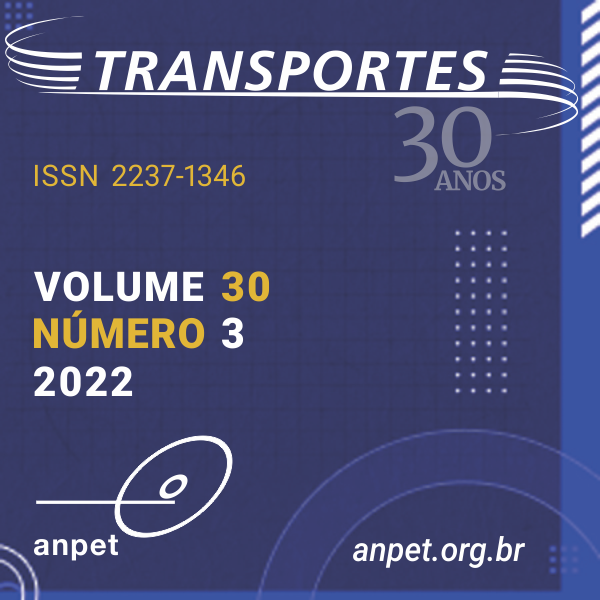Previsão de velocidades de tráfego com rede neural LSTM encoder-decoder
DOI:
https://doi.org/10.14295/transportes.v30i3.2660Palavras-chave:
Breakdown de tráfego, Previsão de tráfego, Redes neuraisResumo
Este artigo tem como objetivo propor uma modelo de previsão de velocidades para um trecho de rodovia na cidade de Porto Alegre, que apresenta congestionamentos diariamente por conta de gargalos. Para realizar as previsões foram utilizados dados de tráfego e variáveis ambientais, como intensidade de chuva, acidentes e eventos atípicos. Propôs-se então um modelo de rede neural com arquitetura encoder-decoder e camadas long short-term memory (LSTM), que possuem a característica de estabelecer relações de longa dependência temporal entre as variáveis de entrada, sendo pertinentes para aplicações na área de Transportes. Como contribuições adicionais, avaliou-se a qualidade das previsões para diferentes horizontes de predição e regimes de tráfego, e comparou-se a capacidade e as curvas de probabilidade de breakdown calculadas com dados de campo e previstos. A metodologia apresentou desempenho satisfatório com base em ambos os critérios, sendo capaz de fazer boas previsões mesmo em situações críticas de tráfego.
Downloads
Referências
do Amaral, M.B. (2020) Previsão de velocidades de tráfego com rede neural LSTM. Bachelor thesis. Departmento de Engenharia Civil: Universidade Federal do Rio Grande do Sul. Porto Alegre, Brazil.
Andrade, G.R. and Setti, J.R. (2014) Speed–Flow Relationship and Capacity for Expressways in Brazil, in Innovative Applications of the Highway Capacity Manual 2010. DOI: http://onlinepubs.trb.org/onlinepubs/circulars/ec190.pdf.
Arras, L. et al. (2019) Explaining and Interpreting LSTMs, Lecture Notes in Computer Science (including subseries Lecture Notes in Artificial Intelligence and Lecture Notes in Bioinformatics), 11700 LNCS(2019), pp. 211–238. DOI: 10.1007/978-3-030-28954-6_11.
Brilon, W., Geistefeldt, J. and Regler, M. (2005) Reliability of Freeway Traffic Flow: A stochastic Concept of Capacity, Proceedings of the 16th International Symposium on Transportation and Traffic Theory, (July), pp. 125–144.
Caleffi, F. et al. (2016) Influência das condições climáticas e de acidentes na caracterização do comportamento do tráfego em rodovias, Transportes, 24(4), p. 57. DOI: 10.14295/transportes.v24i4.1104.
Caleffi, F. (2018) Proposição de um método de harmonização da velocidade baseado em modelo de previsão de conflitos veiculares. PhD Thesis. Departamento de Engenharia de Produção e Transportes: Universidade Federal do Rio Grande do Sul. Porto Alegre, Brazil.
Chollet, F. (2018) Deep Learning with Python. 1st edn. Shelten Island, NY: Manning Publications.
Elefteriadou, L. et al. (2011) Proactive ramp management under the threat of freeway-flow breakdown, Procedia - Social and Behavioral Sciences, 16, pp. 4–14. DOI: 10.1016/j.sbspro.2011.04.424.
Elefteriadou, L. et al. (2014) Enhancing ramp metering algorithms with the use of probability of breakdown models, Journal of Transportation Engineering, 140(4), pp. 1–9. DOI: 10.1061/(ASCE)TE.1943-5436.0000653.
Fortunato, M., Blundell, C. and Vinyals, O. (2017) Bayesian Recurrent Neural Networks, pp. 1–14. DOI: 10.48550/arXiv.1704.02798.
Fu, R., Zhang, Z. and Li, L. (2017) Using LSTM and GRU neural network methods for traffic flow prediction, Proceedings - 2016 31st Youth Academic Annual Conference of Chinese Association of Automation, YAC 2016, pp. 324–328. DOI: 10.1109/YAC.2016.7804912.
Gal, Y. and Ghahramani, Z. (2016) A theoretically grounded application of dropout in recurrent neural networks, Advances in Neural Information Processing Systems, pp. 1027–1035. DOI: 10.48550/arXiv.1512.05287.
Galvan, Y.T., Zechin, D. and Cybis, H.B.B. (2019) Utilização do método Kaplan-Meier na estimativa das distribuições de velocidade desejada, Anais do 33º Congresso de Pesquisa e Ensino em Transportes - 2019. Rio de Janeiro: Associação Nacional de Pesquisa e Ensino em Transportes.
Géron, A. (2019) Hands-On Machine Learning with Scikit-Learn, Keras & TensorFlow. 2nd edn. Sebastopol: O’Reilly Media
Gu, Y. et al. (2019) Short-term prediction of lane-level traffic speeds: A fusion deep learning model, Transportation Research Part C: Emerging Technologies, 106(July), pp. 1–16. DOI: 10.1016/j.trc.2019.07.003.
Han, Y. and Ahn, S. (2018) Stochastic modeling of breakdown at freeway merge bottleneck and traffic control method using connected automated vehicle, Transportation Research Part B: Methodological, 107, pp. 146–166. DOI: 10.1016/j.trb.2017.11.007.
Hochreiter, S. and Schmidhuber, J. (1997) Long Short-Term Memory, Neural Computation, 9(8), pp. 1735–1780. DOI: 10.1162/neco.1997.9.8.1735.
Iung, B. (2013) Cœur et grossesse, EMC - Traité de médecine AKOS, 8(2), pp. 1–4. DOI: 10.1016/s1634-6939(13)59289-1.
Kendall, A. and Gal, Y. (2017) What uncertainties do we need in Bayesian deep learning for computer vision?, Advances in Neural Information Processing Systems, 2017-December(Nips), pp. 5575–5585. DOI: 10.48550/arXiv.1703.04977.
Laptev, N. et al. (2017) Time-series Extreme Event Forecasting with Neural Networks at Uber, International Conference on Machine Learning - Time Series Workshop, pp. 1–5. Available at: <http://www.cs.columbia.edu/~lierranli/publications/TSW2017_paper.pdf>. Accessed at: 12/08/2022.
Li, L. et al. (2018) Hyperband: A novel bandit-based approach to hyperparameter optimization, Journal of Machine Learning Research, 18, pp. 1–52. DOI: 10.48550/arXiv.1603.06560.
Li, Y., Wang, N. and Carroll, R.J. (2010) Generalized functional linear models with semiparametric single-index interactions, Journal of the American Statistical Association, 105(490), pp. 621–633. DOI: 10.1198/jasa.2010.tm09313.
Ma, X. et al. (2015) Long short-term memory neural network for traffic speed prediction using remote microwave sensor data, Transportation Research Part C: Emerging Technologies, 54, pp. 187–197. DOI: 10.1016/j.trc.2015.03.014.
Ma, Y., Zhang, Z. and Ihler, A. (2020) Multi-Lane Short-Term Traffic Forecasting with Convolutional LSTM Network, IEEE Access, 8, pp. 34629–34643. DOI: 10.1109/ACCESS.2020.2974575.
Neil, D., Pfeiffer, M. and Liu, S.C. (2016) Phased LSTM: Accelerating recurrent network training for long or event-based sequences, Advances in Neural Information Processing Systems, (Nips), pp. 3889–3897. DOI: 10.48550/arXiv.1610.09513.
Pujol, B.S., Asplund, M. and Serra, J.C. (2019) Machine learning for early detection of traffic congestion using public transport traffic data. Bachelor Thesis. Department of Computer and Information Science Machine: Linköping University. Linköping, Sweden.
Vlahogianni, E.I., Karlaftis, M.G. and Golias, J.C. (2014) Short-term traffic forecasting: Where we are and where we’re going, Transportation Research Part C: Emerging Technologies, 43, pp. 3–19. DOI: 10.1016/j.trc.2014.01.005.
Zechin, D., Caleffi, F. and Cybis, H.B.B. (2020) Influence of Rain on Highway Breakdown Probability, Transportation Research Record, 2674(8), pp. 687–695. DOI: 10.1177/0361198120919754.
Downloads
Publicado
Como Citar
Edição
Seção
Licença
Copyright (c) 2022 Douglas Zechin, Matheus Basso do Amaral, Helena Beatriz Bettella Cybis

Este trabalho está licenciado sob uma licença Creative Commons Attribution 4.0 International License.
Ao submeter um manuscrito para publicação neste periódico, todos os seus autores concordam, antecipada e irrestritamente, com os seguintes termos:
- Os autores mantém os direitos autorais e concedem à Transportes o direito de primeira publicação do manuscrito, sem nenhum ônus financeiro, e abrem mão de qualquer outra remuneração pela sua publicação pela ANPET.
- Ao ser publicado pela Transportes, o manuscrito fica automaticamente licenciado sob a Licença Creative Commons CC BY 4.0. Esta licença permite o seu compartilhamento com reconhecimento da autoria e da publicação inicial neste periódico.
- Os autores têm autorização para assumir contratos adicionais separadamente, para distribuição não exclusiva da versão do trabalho publicada neste periódico (por ex.: publicar em repositório institucional ou como capítulo de livro), com reconhecimento da publicação inicial na Transportes, desde que tal contrato não implique num endosso do conteúdo do manuscrito ou do novo veículo pela ANPET.
- Os autores têm permissão e são estimulados a publicar e distribuir seu manuscrito online (por ex.: em repositórios institucionais ou na sua página pessoal) depois de concluído o processo editorial. Como a Transportes é de acesso livre, os autores são estimulados a usar links para o DOI do artigo nesses casos.
- Os autores garantem ter obtido a devida autorização dos seus empregadores para a transferência dos direitos nos termos deste acordo, caso esses empregadores possuam algum direito autoral sobre o manuscrito. Além disso, os autores assumem toda e qualquer responsabilidade sobre possíveis infrações ao direito autoral desses empregadores, isentando a ANPET e a Transportes de toda e qualquer responsabilidade neste sentido.
- Os autores assumem toda responsabilidade sobre o conteúdo do manuscrito, incluindo as devidas e necessárias autorizações para divulgação de dados coletados e resultados obtidos, isentando a ANPET e a Transportes de toda e qualquer responsabilidade neste sentido.










